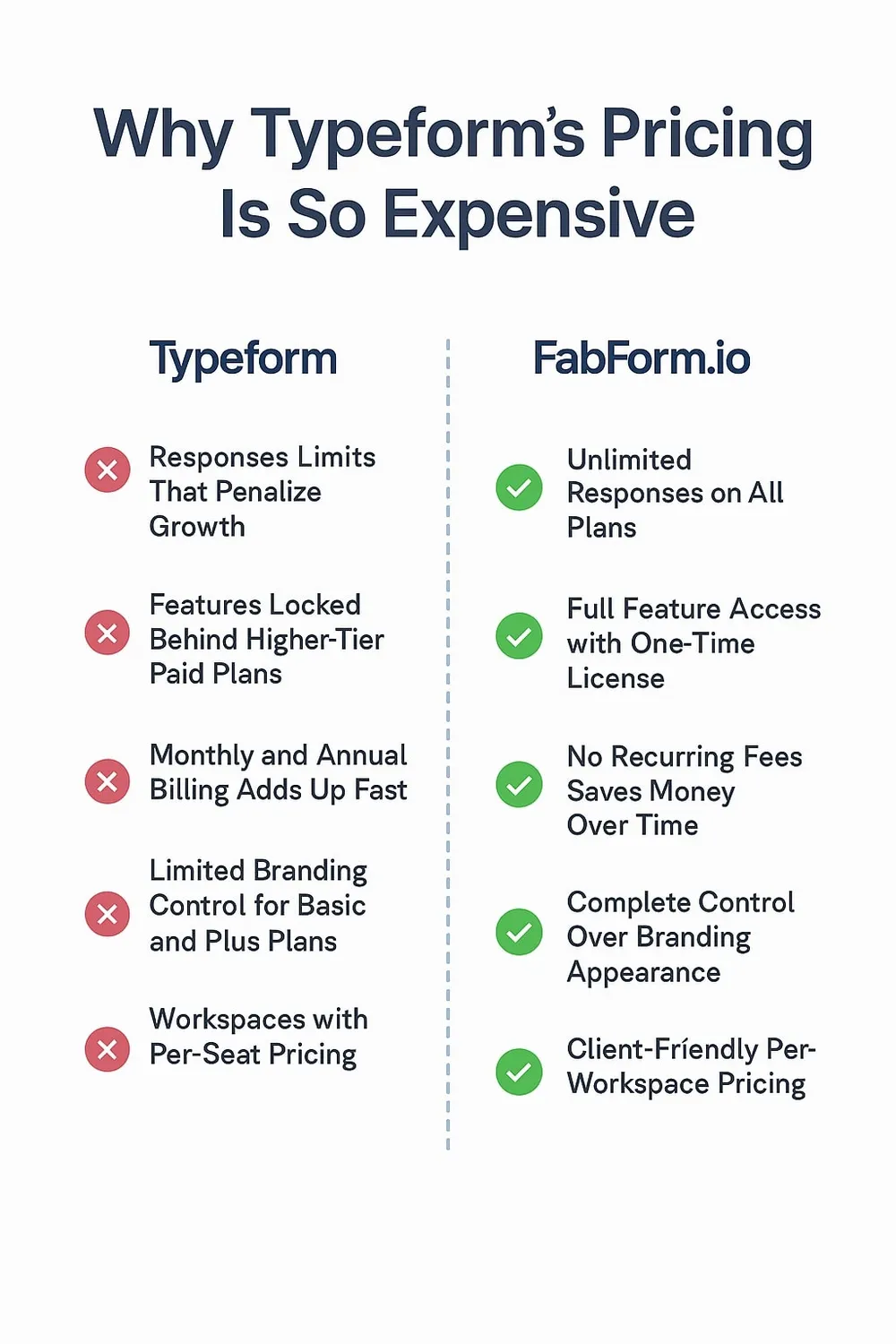Explore the hidden costs of Typeform’s pricing model—response limits, branding restrictions, and recurring fees—and discover how FabForm.io offers a scalable, one-time-payment alternative for marketers and growth teams.
Typeform is widely known for its sleek interface and conversational flow. It’s a popular choice for startups, marketers, and creators who want forms that feel modern and engaging. But once you move beyond the free plan, many teams discover that Typeform’s pricing model isn’t just expensive—it’s restrictive, unpredictable, and difficult to scale.
If you’ve ever searched for “Typeform alternatives with unlimited responses” or “how to remove Typeform branding,” you’re not alone. Thousands of users hit the same wall: they outgrow Typeform’s limits, but upgrading feels like paying more for less control.
Response Limits That Penalize Growth
Typeform’s paid plans still cap the number of responses you can collect. For marketers running lead generation campaigns or product teams gathering feedback, this creates a paradox: the more successful your form is, the more you pay.
- Free plan: 10 responses/month
- Basic plan: 100 responses/month
- Plus plan: 1,000 responses/month
If you exceed these limits, you’re forced to upgrade—even if you don’t need additional features.
Essential Features Locked Behind Higher Tiers
Want to remove Typeform’s branding? Add custom logic? Integrate with your CRM? You’ll need to pay more.
- Custom branding: Only available on Plus and Business plans
- Logic jumps: Limited on lower tiers
- Integrations: Restricted unless you upgrade
This tiered approach means you’re not paying for what you use—you’re paying to unlock what should be standard.
Recurring Costs That Add Up Fast
Typeform’s monthly or annual billing model creates ongoing costs, even if your usage is seasonal or project-based. Agencies managing multiple clients often need separate workspaces, multiplying the expense.
- Monthly billing: £25–£70+ per workspace
- Annual billing: Slight discount, but still recurring
- No one-time payment option
For freelancers, small businesses, and growth teams, this pricing model quickly becomes unsustainable.
Limited Branding Control
Unless you’re on a higher-tier plan, your forms carry Typeform’s logo. This undermines your brand and creates a disjointed experience for users.
- No SVG logo support
- Limited header customization
- Typeform branding visible on lower plans
For teams that care about design and brand consistency, this is a dealbreaker.
Workflow Complexity and Integration Friction
Typeform’s logic jumps and integrations often feel clunky or limited. Connecting to external tools like Supabase, Airtable, or custom APIs requires workarounds or third-party services.
- No native support for Supabase workflows
- Limited control over backend logic
- No built-in paid status tracking
This forces developers and marketers to compromise on automation and data flow.
What Users Are Actually Searching For
While they may not always say “I hate Typeform,” their search behavior tells the story. These are real-world phrases users type when they’re frustrated:
- “Typeform too expensive for small business”
- “form builder with unlimited responses”
- “remove Typeform branding”
- “affordable Typeform alternative”
- “form builder with one-time payment”
- “Typeform response limit workaround”
- “form builder for client projects without per-seat pricing”
These are high-intent queries from users actively looking for better options.
FabForm.io isn’t just another form builder—it’s a refined, scalable alternative designed for marketers, designers, and growth teams who care about clarity, control, and conversion.
One-Time Pricing
No subscriptions. No response limits. No surprise bills. Pay once, use forever.
Full Branding Control
Upload your own SVG logo, customize headers, and remove all third-party branding.
Elegant UX and Conversion-Focused Design
Forms that look refined, load fast, and guide users smoothly to completion.
Idiomatic Supabase Workflows
Built for developers who want clean, secure backend logic—especially for paid status tracking and user metadata.
Every form is optimized for discoverability, with clean URLs and metadata that support organic growth.
Conclusion: Stop Paying to Scale
Typeform’s pricing model isn’t broken—it’s just not built for teams who value control, clarity, and growth. If you’re tired of recurring fees, limited features, and branding restrictions, it’s time to switch.
FabForm.io gives you the freedom to grow without penalty. Whether you’re running lead generation campaigns, onboarding users, or collecting feedback, FabForm lets you do it elegantly, affordably, and on your terms.
Try FabForm.io today—the form builder that respects your brand, your budget, and your backend.
